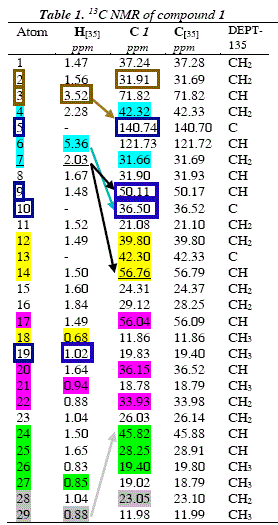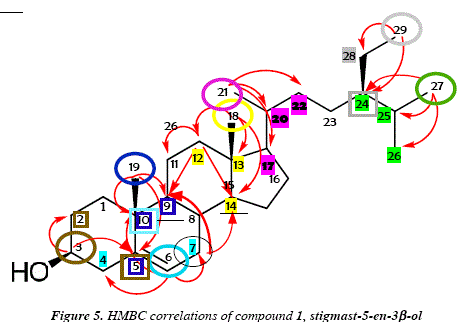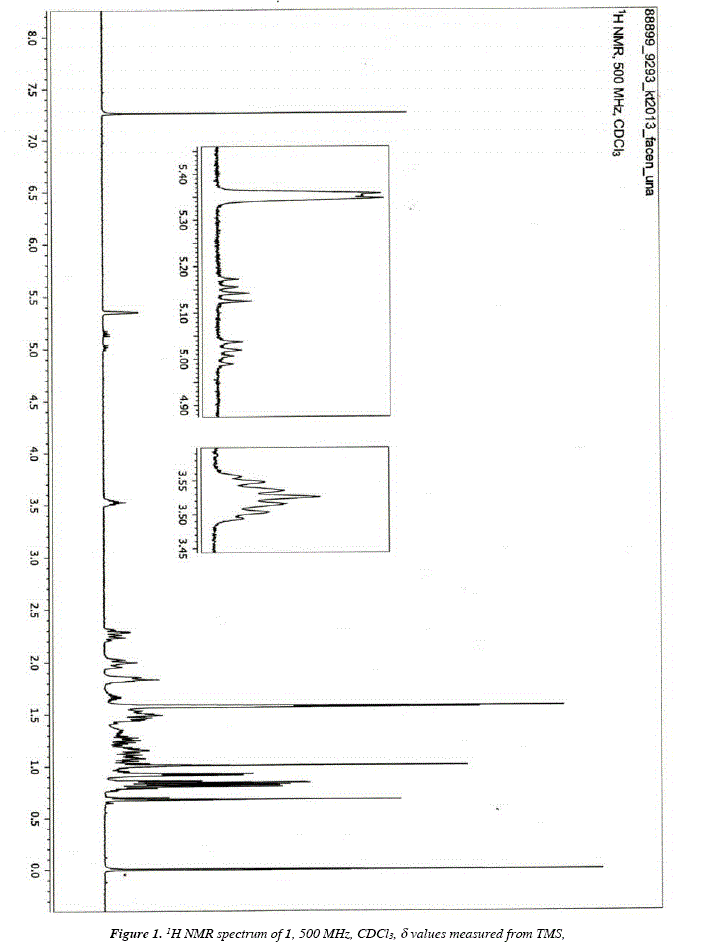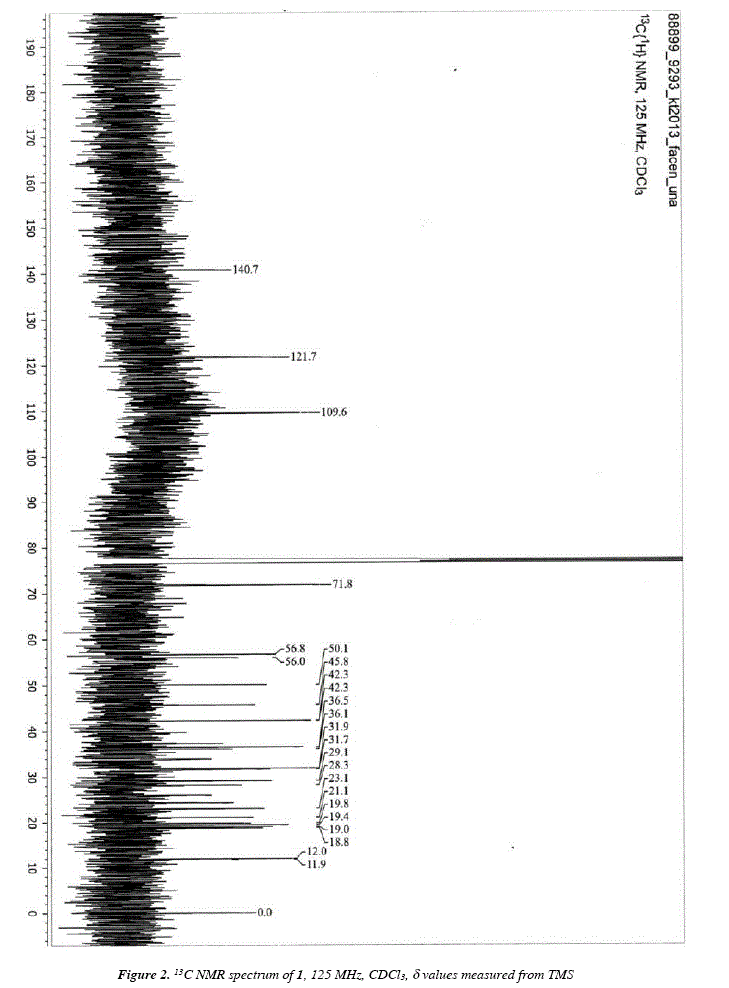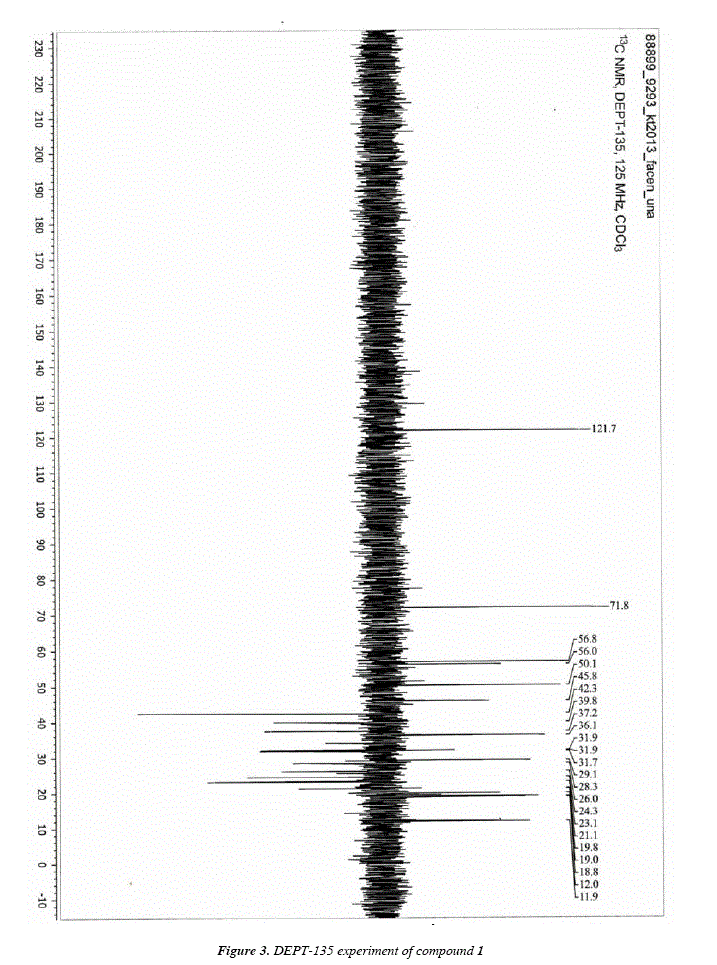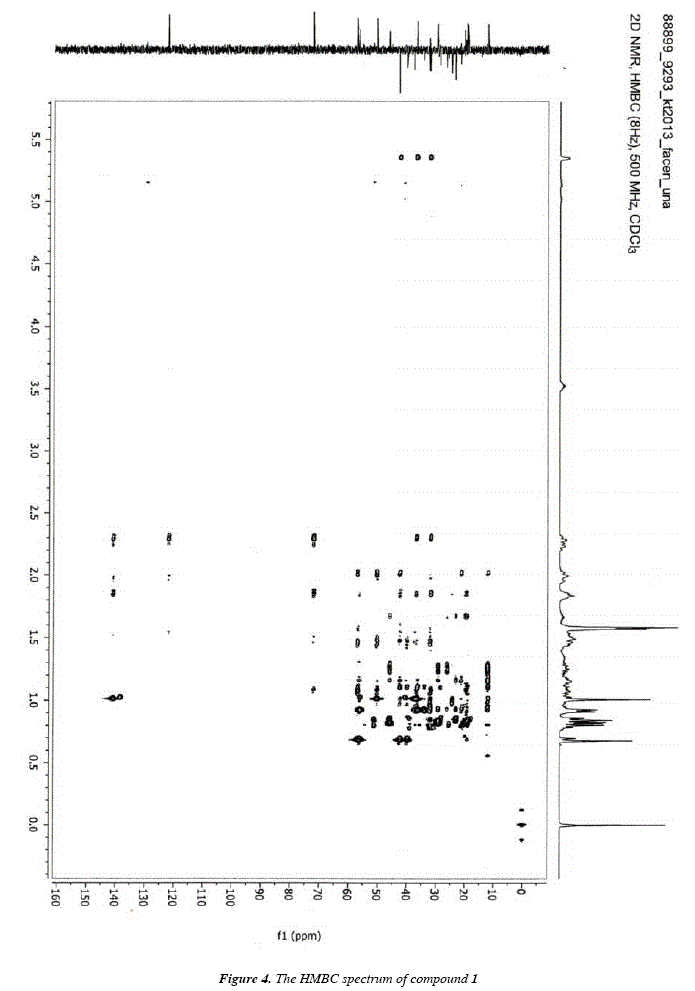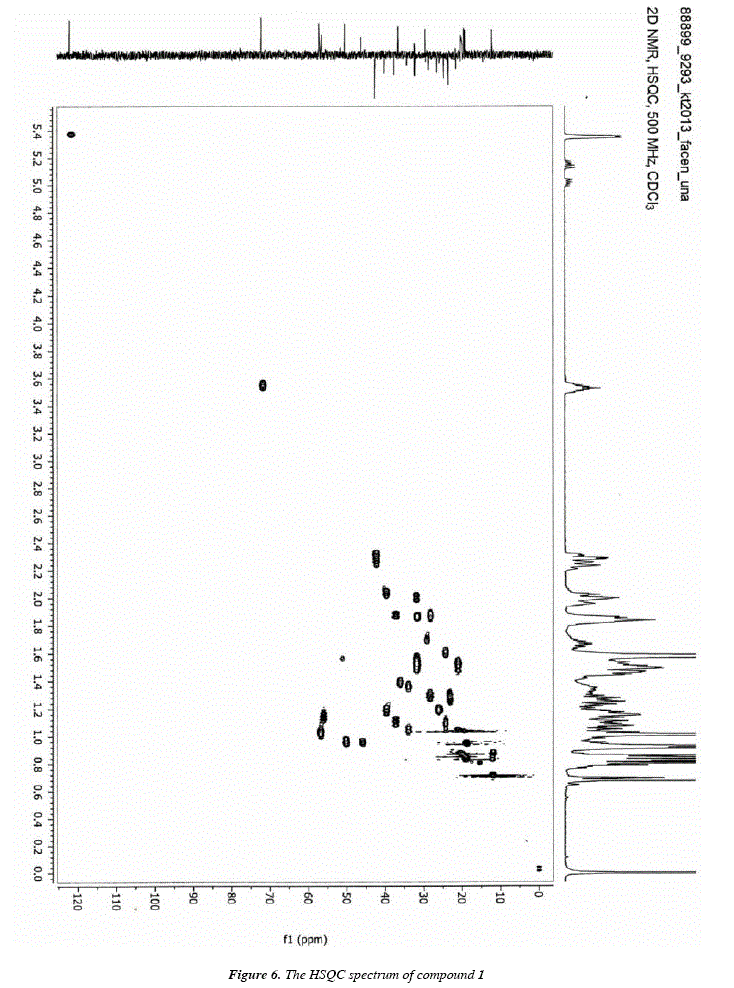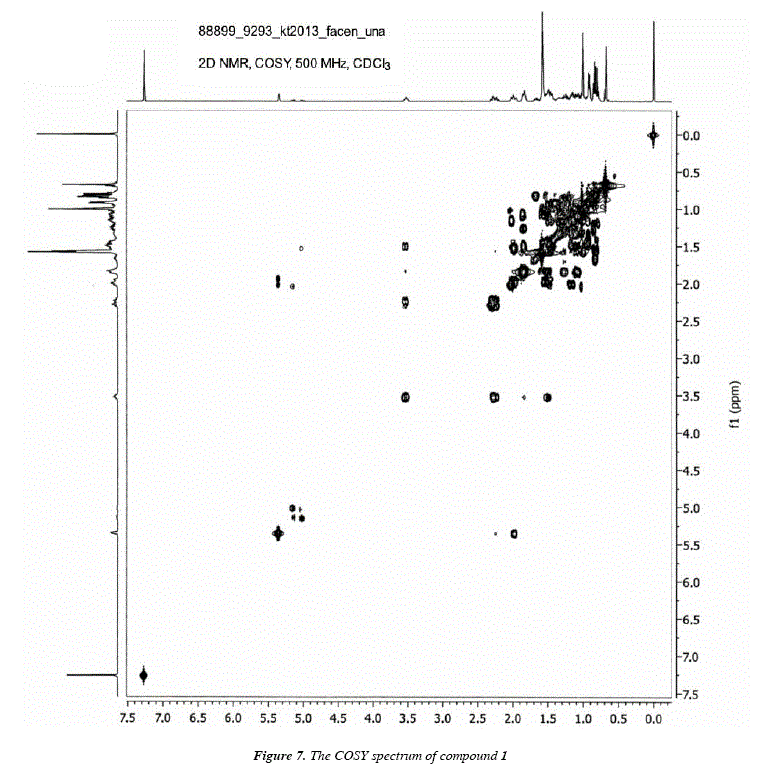Revista Boliviana de Química
versão On-line ISSN 0250-5460
Rev. Bol. Quim v.34 n.1 La Paz abr. 2017
ARTÍCULOS ORIGINALES
DETERMINATION OF AN ACTIVE PRINCIPLE OF POLYGONUM PUNCTATUM ELUOT; FULL NMR SPECTRA OF STIGMAST-5-EN-3P-OL (500/125 MHz)
DETERMINACIÓN DE UN PRINCIPIO ACTIVO DE POLYGONUM PUNCTATUM ELLIOT; ESPECTROS COMPLETOS DE RMN DE STIGMAST-5-EN-3P-OL (500/125 MHZ)
Miguel Martínez1-*, Bonifacia Benítez1, Sandra Alvarez2, Rebeca Prieto3, Mónica Rolón3, Gil Valdo José Da Silva4, José A. Bravo5, José L. Vila6
*Corresponding author: miguelfacen@gmail.una.py
Received 05 22 2017 Accepted 05 23 2017 Published 05 31 2017
ABSTRACT
The aim of this report is to provide full NMR spectra (:H 500 MHz, 13C 125.8 MHz) of stigmast-5-en-3/?-ol (1), whose other common ñames are: /f-sitosterol, /f-sitosterin, 22,23-dihydrostigmasterol, and IUPAC ñame: 17-(5-ethyl-6-methylheptan-2-yl)-10,13-dimethyl-2,3,4,7,8,9,ll,12,14,15,16,17-dodecahydro-l-cyclopenta[a]phenanthren-3-ol., and IUPAC ñame: The spectra set includes HMBC, HSQC and COSY studies. ROESY or NOESY studies were excluded. Compound 1 is found to be the major component of the alcoholic extract of roots of Polygonum punctatum (Polygonaceae), a macrophyte native species of Paraguay with varied therapeutic applications like anti-inflammatory among others. Compound 1 was extracted by maceration in EtOH 96° and it was isolated by using chromatographic techniques. A bibliographic research allowed to establish a correlation between traditional medicine information of anti-inflammatory property of P. punctatum and the isolated compound 1 for which a series of reports about its pharmacological properties permitted to affirm that 1, being the major secondary metabolite in the alcoholic extract of roots, is one of the active principies of the plant, namely the anti-inflammatory principie. The spectroscopic work and the structural elucidation permitted the identification of compound 1 as /f-sitosterol. The bibliographic research allowed to label /f-sitosterol (1) as a new compound in the species P. punctatum for which only polygodial, a potent antifungal sesquiterpene, was previously described. With the present reporting of compound 1 in P. punctatum, the total number of secondary metabolites and active principies thus far described in the species reaches the cipher of two (according to the newest bibliographic review on the chemical content of the Polygonum genus, 2014).
Keywords: Stigmast-5-en-3-ol, Sitosterol, Polygonum punctatum Elliott, Polygonaceae, Roots, Anti-inflammatory, NMR spectra, 500 MHz.
RESUMEN
Spanish title: Determinación de un principio activo de Polygonum punctatum; espectros completos de RMN de stigmast-5-en-3¡5-ol (500/125 MHz). El objetivo de este artículo es proveer de información espectral completa de stigmast-5-en-3y3 -ol (1), cuyos otros nombres comunes son: /f-sitosterol, /f-sitosterin, 22,23 -dihydrostigmasterol, and IUPAC ñame: 17-(5-ethyl-6-methylheptan-2-yl)-10,13-dimethyl-2,3,4,7,8,9,ll,12,14,15,16,17-dodecahydro-l-cyclopenta[a]phenanthren-3-ol., and IUPAC ñame: La colección de espectros incluye los estudios HMBC, HSQC and COSY. Los estudios ROESY o NOESY no están contemplados. El compuesto 1 resultó ser el componente mayoritario del extracto alcohólico de Polygonum punctatum (Polygonaceae), especie macrófita nativa de Paraguay con aplicaciones terapéuticas como: hemorroides, abortos y otras. El compuesto 1 fue extraído por maceración en etanol 96° y aislado mediante la aplicación de técnicas cromatográficas. Una investigación bibliográfica permitió establecer una correlación entre la información de la medicina tradicional de la propiedad antiinflamatoria de P. punctatum y el compuesto aislado 1 para el cual una serie de informes sobre sus propiedades farmacológicas permitió afirmar que 1, siendo el componente mayoritario del extracto alcohólico de las raices, es uno de los principios activos de la planta, es decir, el principio anti-inflamatorio. El trabajo espectroscópico y la elucidación estructural condujeron a la identificación del compuesto 1 como /f-sitosterol. La investigación bibliográfica permitió añadir p-sitosterol (1) como un nuevo compuesto en la especie Polygonum punctatum para la cual solo se describió previamente un sesquiterpeno antifúngico potente, polygodial. Con la presente descripción del compuesto 1 en P. punctatum, el número total de metabolitos secundarios y principios activos hasta ahora descritos en la especie alcanza la cifra de dos (según la última revisión bibliográfica sobre el contenido químico del género Polygonum, 2014).
INTRODUCTION
Polygonum genus review
Various species of the genus Polygonum (Polygonaceae) are of common use in traditional Chinese medicine due to their effects on diverse health disorders, e.g. antioxidant, anti-inflammatory, antibacterial and antifungal, anticancer, antiviral, lipid-regulating, neuroprotective and the estrogenic effect [1]. Thirty-four different Polygonum species have been reported as the source for different traditional medicine uses in the eastern Himalayan región, India [2]. The plant remedies are used as astringent, laxative, febrifuge, demulcent, tonic, diuretic, gonorrhea relief, relief of menstrual and other gynecological problems, dysentery relief, chest related problems relief, wound healing agents, jaundice relief, piles relief, muscular pain relief, cardiac problems relief, colic relief [2]. As Polygonum punctatum Elliott is endemic in the three Americas, it is traditionally used in Paraguay for sore throats and colds (anti-inflammatory) [3]. Important discoveries in the treatment of various illnesses like for instance those related to snake-bites, inflammatory problems, cáncer, bacteria, viral infections, antiseptic, fungal, diabetic, hypertension, hyperlipemia, jaundice, hemorrhage, cough, fever, ulcers, skin affections, anemia, diarrhea and various urologic disorders, have been exposed in ethnobotanical informs and some of them have been in some degree proved by experimental approaches on ethanol extracts of some Polygonum species [4]. For example, Polygonum cuspidatum is useful as analgesic, antipyretic, diuretic, and expectorant as well as for the healing of arthralgia, chronic bronchitis, jaundice, amenorrhea and high blood pressure, according to Chinese traditional medicine [5]. Polygonum cuspidatum has been evaluated with respect to its antioxidant capacity [6,7] as well as for example the anti-inflammatory activity as inhibitor of NF-kb [8,9,10]. The antinociceptive, anti-inflammatory and diuretic properties of Polygonum barbatum (L.) have been assessed on the mice/rat model; the plant was collected in Bangladesh [11]. The thrombolytic activity, the membrane stabilizing activity and the cytotoxic activity of Polygonum hydropiper was evaluated. The thrombolytic activity, the membrane stabilizing activity were assessed by means of the use of human erythrocytes, the results were compared with standard streptokinase and acetyl salycilic acid as standard anti-inflammatory respectively. Citotoxicity was established by Brine shrimp lethality bioassay. The plant was provided from Bangladesh. Phytochemical screening revealed the presence of saponines, steroids, flavonoids and carbohydrates in extracts derived from the applying of organic solvents of increasing polarity to the plant material [12]. Polygonum hydropiperoides and P. spectabile traditionally employed by their medicinal properties namely anti-inflammatory, antihaemorrhoidal and anti-diarrhea have been studied under a pharmacognostic scope. The pharmacognosy screening approach employed revealed the presence of triterpenes and/or steroids, coumarins, flavonoids, polyphenols, tannins and saponins. The plant samples were collected in Minas Gerais, Brazil [13]. Polygonum hydropiperoides also showed activity against Staphylococcus aureus, confirming the traditional use of the leaves of the plant against bacteria; plant samples were collect in northern Perú [14]. The leaves of Polygonum persicaria find application as astringent, rubefacient and vermifuge [15,16], the hydromethanolic extract of the leaves manifested good activity against Staphylococcus aureus and Enterobacter aerogenes [15]. Polygonum plebejum is used in case of pneumonia [15,17,18]; a good activity was found for the hydrodromethanolic extract against Pseudomonas aeruginosa and Enterobacter aerogenes [15]. Polygonum persicaria and P. plebejum showed important insecticidal activity against Tribolium castaneum [15]. Polygonum cognatum showed activity against Staphylococcus aureus and Bacillus subtilis [15,19]. Quercetin from Polygonum equisetiforme is the responsible for the narrowed spectrum and high activity against Citrobacter frundii, Escherichia coli, Enterobacter aerogenes, Staphylococcus aureus, Salmonella typhi, Pseudomonas aeruginosa [15,20]. Polygonum chínense has been evaluated for its antifungal activity [15,21]. Polygonum persicaria was investigated due to its ethnopharmacological information regarding an antifungal activity; polygodial showed good activity against yeasts and dermatophytes [22]. The Bangladeshi medicinal plant Polygonum stagninum Buch.-Ham. ex Meissn. was evaluated due to analgesic and anti-inflammatory properties by examining its extracts of n-hexane, ethyl acétate (EtOAc), and methanol of the aerial parts [23].
Polygonum punctatum review
Polygonum punctatum (Pp) known in Brazil as "erva-de-bicho", is ethno-pharmacologically described for the treatment of intestinal disorders [15,24]. Also, the dichloromethane extract of the aerial parts of Pp manifested strong activity in a bioautographic assay over the fungus Cladosporium sphaerospermum] the procedure afforded the sesquiterpene dialdehyde: polygodial as the antifungal active principie of the dichloromethane extract [15,24]. For a complete approach to the pharmacological properties of polygodial see reference [24] and related references therein. Pp is mentioned as an anti-inflammatory and diuretic in traditional medicine treatments [11]. According to Choudary et al., the leaves of Pp are employed for swelling treatments [2]. Pp is used as antifungal, antihistaminic, anti-inflammatory and hypotensive [4,24,25]. Pp was included as part of a study carried out to show the importance of non-arboreal native plants in maintaining a rich diversity of bees in Santa Catarina island, southern Brazil [26]. According to the authors, shoots of Pp are used to treat varicose veins and varicose ulcers. The plant, together with other 58 Brazilian plants, was analyzed with respect to its contents in diverse metáis by neutrón activation analysis and atomic absorption [27]. The antibacterial (Gram+ and Gram-) and antifungal activity was evaluated for native species of Argentina including Pp; the 50% hydroethanolic extract of the aerial parts was used as starting vegetal material [28]. A wide antimicrobial activity of the dichloromethane and methanol extracts of the aerial parts of Pp was found: The dichloromethane extract was active against Bacillus subtillis, Micrococcus luteus, histeria monocytogenes y Staphylococcus aureus. The methanol extract was active against B. subtilis, M. luteus. L. monocytogenes y S. aureus. This same extract was active against Aspergillus níger. The dicloromethane extract was active against Candida albicans y A. niger [29]. The good anti-inflammatory activity pf Pp was established by Carrageenan-induced pedal edema/gastric intubation in rats [25,30]. Pp was reported as a plant for healing wounds in Brazil [31]. /3-Bisabolene is the major monoterpene component of the essential oil of Pp; the anti-inflammatory ethnopharmacological property as well as the antifungal and antibacterial activity of its organic extracts is mentioned [28,32,33]. The mutagenic and genotoxic potential of Pp was evaluated; infusions and extracts of leaves showed reduced valúes of mitotic Índices in the concentrations used compared to the control in distilled water. Chromosomal alterations were identified in the cell división in all concentrations of infusions and extracts, demonstrating that the plant possesses antiproliferative and genotoxic properties [34].
RESULTS AND DISCUSSION
Given the fact of plenty of references allusive to the ethnopharmacological medicinal properties of the aerial parts of Polygonum punctatum used under different forms, and that to the best of our knowledge the roots of the species have not yet been studied, we have carried out the phytochemical approach to this organ in the species. Moreover, let's signal at this point, that according to the most recent phytochemical bibliographic review on the genus [4], only polygodial has been thus far reported in the aerial parts of the species [24]. We contribute in the present work with the presence of /3-sitosterol in the roots of the species as the major metabolite. The plant was collected in Departamento Central, Paraguay, and the treatment of the roots included the extraction by ethanol 96% solvent and the isolation of the major compound /3-sitosterol (1) by chromatographic means. The identification of 1 was possible thanks to the application of NMR techniques.
Succinct spectral/structural heteronuclear remote correlations ofl by NMR
The 1H NMR spectrum of 1 (Fig. 1) shows aliphatic signáis between δ 2.50 and δ 0.65; this spectral zone comprehends methyl and methylene protons. At δ 3.51 ppm a multiplet corresponding to a methine and at δ 5.35 a double doublet corresponding to a vinyl protón. The concomitant analysis of the 13C NMR (Fig. 2) and the DEPT-135 spectra of 1, (Fig. 3) resulted in the establishment of 3 quaternaries, 9 methines, 11 methylene, and 6 methyl groups for a total of 29 carbons. The analysis of the HMBC spectrum of 1 (Fig. 4) conducts to the establishment of remote heteronuclear correlations for the protons of the seven methyl groups as follows. Protons at δ![]() (
(![]() ) are remotely coupled to carbons at
) are remotely coupled to carbons at ![]() ppm (
ppm (![]() ),
), ![]() ppm (
ppm (![]() ) and
) and ![]() ppm (
ppm (![]() ). The methyl protons at δ
). The methyl protons at δ ![]() (
(![]() ) are correlated to carbons at δ
) are correlated to carbons at δ![]() (
(![]() ) δ
) δ ![]() (
(![]() ) and δ
) and δ ![]() (
(![]() ). The methyl protons at δ
). The methyl protons at δ ![]() (
(![]() ) are connected to carbons at δ
) are connected to carbons at δ ![]() (
(![]() ) δ
) δ![]() (
(![]() ) and δ
) and δ ![]() (
(![]() ). The methyl at δ
). The methyl at δ ![]() (
(![]() ) can be correlated to δ
) can be correlated to δ ![]() (
(![]() ), δ
), δ ![]() (
(![]() ) and δ
) and δ ![]() (
(![]() ). The methine protón δ
). The methine protón δ![]() (
(![]() ) can be correlated to the quaternary δ
) can be correlated to the quaternary δ![]() (
(![]() ) and the methylene at δ
) and the methylene at δ ![]() (
(![]() ).
).
The methylene protons resonating at δ 2.0 (H-7) find correlation with carbons at δ 56,8 (C-14) and δ501 (C-9), δ. The methyl protons at δ ![]() (
(![]() ) correlate to the methine at δ
) correlate to the methine at δ ![]() (
(![]() ) and with carbón δ
) and with carbón δ ![]() (
(![]() ). Protón δ
). Protón δ ![]() (
(![]() ) can be correlated to carbons at
) can be correlated to carbons at ![]() ppm (
ppm (![]() ),
), ![]() ppm (
ppm (![]() ) and 42.3
) and 42.3![]() ppm (
ppm (![]() ). These correlations are graphically exposed in Fig. 5. The established structure corresponds to stigmas-5-en-3y3-ol according to the comparison of 13C chemical shift valúes of 1 and /f-sitosterol previously published [35]in Table 1.
). These correlations are graphically exposed in Fig. 5. The established structure corresponds to stigmas-5-en-3y3-ol according to the comparison of 13C chemical shift valúes of 1 and /f-sitosterol previously published [35]in Table 1.
The full establishment of the planar structure of 1 was achieved not only on the basis of the analysis of the HMBC spectrum (Fig. 4) but also by the complementary using of the HSQC (Fig. 6) and the COSY spectrum (Fig. 7).
From Fig. 5 and Table 1 it's possible to notice that following the colors that agglutinate protón and carbons in seven different groups (seven colors) and an eighth group (underlined in Table 1), from 29 carbons there are only six groups: CH2-1, CH-8, CH2-11, CH2-15, CH2-I6 and CH3-23, that have not been correlated in any form by the HMBC experiment (they're neither colored nor underlined); this shows the high potential of the technique HMBC in connecting atoms in the inside of different structural portions of the global structure as well as between pairs of partial structures in order to correlate them. Complementarily, structural information can be derived from spectral data by means of the analysis of the homonuclear vicinal and geminal couplings exhibited by the COSY experiment (Fig. 7). The fundamental spectrum HSQC (Fig. 6) permits the ultímate completion of Table 1 with respect to every chemical shift valué in protons as well as in the carbón frequency.
EXPERIMENTAL
General
NMR experiments were performed at room temperature (298 K) on a Bruker DRX 500 spectrometer (B0 11.7 T) equipped with a mm inverse multinuclear probe (500.13 MHz for 1H and 125.77 MHz for 13C). NMR data were processed using TopSpin software by Bruker BioSpin; chemical shifts were referenced to TMS as internal standard. Sample for NMR analyses was dissolved in CDCI3 in a 5 mm NMR tube. Ethanol 96% of commercial origin and no further purified. Chromatographic tools can be characterized as follows. Aluminum TLC plates coated with silica gel 60 F254, 20X20 cm, 250 |Jm by MERCK. Revealing agent: H2SO4 30 % aqueous solution plus heating. LC open column: silica gel 60 G, 0.063-0.200 mm, 70-230 Mesh ASTM by SCHARLAU, LC open column solvents by SIGMA ALDRICH: hexane p.a., ethyl acétate p.a. Other equipment: BÜCHI rotavapor R-200 and heating bath B-490 plus diaphragm vacuum pump ILMVAC.
Plant material
Polygonum punctatum Elliot, in Sketch Bot. S. Carolina [Elliott] 1: 455. 1817 [Dec 1817]. Syn.: Polygonum acre Kunth, hom. illeg., Polygonum epilobioides Wedd., Polygonum hydropiperoides Pursh, hom. Illeg., was collected at compañía Piquete Cué Limpio City, Departamento Central, Republic of Paraguay in summer 2012. The GPS coordinates were: 25°19'39.26"S, 57°25'26.43"O. A voucher specimen under the code MMN°:09 was deposited at FACEN Herbarium, School of Natural and Exact Sciences of Universidad Nacional de Asunción. The taxonomic identification was done by one of us (B. Benítez) through the use of the key of Cialdella & Brandbyge (Flora del Paraguay - 33- Polygonaceae. Conservatoire et Jardin botaniques de Genéve de la Ville de Genéve & Missouri Botanical Garden. pp. 106. 2001). The nomenclature was verified in Trópicos (Trópicos.org.Missouri Botanical Garden. 22 May 2017. In: http://www.tropicos.org/Name/26000886, 2017) and in Flora del Cono Sur (2016), and The Plant List (2015).
Extraction and isolation of 1
800 g of ground dry roots were macerated in 3.3 L of ethanol 96% thrice (10 L in total) during one week. The three macerates were added in one to sum up a total of 7 L of ethanol extract. The extract was driven to dryness by elimination of solvent under reduced pressure. The ethanol dry extract weighed 280 g (35% yield with respect to starting material). 1 g of dry ethanolic extract of roots was chromatographed in a LC open column using 10 g of silica gel as stationary phase and a binary mixture of the hexane-ethyl acétate system (hex/EA). Various volumes of the binary mixture hex/EA were prepared: (100/0, 100 mL), (95/5, 100 mL), (90/10, 100 mL), (85/15, 100 mL), (80/20, 100 mL), (70/30, 100 mL), (0/100, 100 mL). 205 fractions of 15 mL each were collected. The composition of fractions and the increment of polarity of the binary mixture added was monitored by TLC plates using hexane puré, and a gradient of hex/EA as eluent of plates. The 205 fractions were regrouped in 13 new fractions according to TLC analyses. The 13 fractions were analyzed in a general view in analytical TLC píate using hex/EA 70/30. Each new fraction was evaporated at reduced pressure and weighed. Frl: 1-8 (90 mg), Fr2: 8-21 (110 mg), Fr3, 22-52 (420 mg), Fr4 (130 mg), 53-64 (44 mg), Fr5: 65-77 (24 mg), Fr6: 78-83 (32 mg), Fr7: 84-88 (65 mg), Fr8: 89-97 (127 mg), Fr9: 98-101 (12 mg), FrlO: 102-153 (12 mg), Frll: 154-187 (13 mg): Frl2: 188-198 (9 mg), Frl3: 200-205 (3 mg). From TLC analyses, Fr3 was chosen for further purification. Dissolved in hex/EA, it was put in refrigerator (-4°C) overnight. White crystals appeared and filtered to recrystallize in ethanol. The NMR analyses of the crystals revealed compound 1. Final weight of 1 was 125 mg (12.5 % by 1 g of extract, 0.047 % of extract, 0.02 % of roots of the plant). Fr2 and Fr4 contained only traces of compound 1.
Spectral data of compound 1
For 13C NMR data of compound 1 see Table 1.
CONCLUSIONS
We have boarded the phytochemical approach of the roots of Polygonum punctatum Elliot being this the first report on the subject. We have reported y3-sitosterol for the first time in the plant and particularly in the roots of the species. The other only metabolite previously described was the antifimgal polygodial [24]. y3-sitosterol, although very common in the vegetal kingdom, is a very important natural product. Plenty of uses are attributed to the compound, it has been the object of many patents and the bibliography regarding its varied pharmacological applications is vast. A recent review (2014) on the properties of y3-sitosterol mentions its characteristics as firstly and most important anti-inflammatory, but also as apoptosis inducer, chemopropective and chemopreventive, hypocholesterolemic, angiogenic, analgesic, anthelmintic and antimutagenic, immunomodulatory, partial anticancer in prostate, antioxidant, neuroprotector, antidiabetic, larvicidal, neutralizer of cobra venom, antifungal, antibacterial, and trypanocidal [36]. The absorption of y3-sitosterol by the digestive track is weak [36], henee, y3-sitosterol alone, under the focus of a puré medicine has not the desired efficacy as when contained in an herbal preparation, as for instance a plant extract [36]. Therefore, the traditional medicine reference to the use of plants containing the compound becomes important when determining its biological activities. There is a large bibliography containing information about the anti-inflammatory properties of y3-sitosterol; we mention here only a few, all these studies clearly establish the anti-inflammatory potential of y3-sitosterol when used alone or in conjoint with other substances [37-44]. When studying Cyperus rotundus, y3-sitosterol demonstrated to possess a potent anti-inflammatory activity comparable to that of hydrocortisone and oxyphenbutazone via intraperitoneal. y3-sitosterol also possessed antipyretic activity similar to that of aspirin [37]. The low toxicity of y3-sitosterol was evidenced by its LD50 that was more than 3 g/kg i.p. in mice and minimum ulcerogenic dose was 600 mg/kg i.p. in rats [37]. During the approach to the study of Opuntia ficus-indica (cactus) and thanks to previous results revealing a potent anti-inflammatory activity in the ethanol extract of stems of the species, the methanol extract was fractionated and y3-sitosterol isolated and evaluated to be the anti-inflamatory principie of the methanol extract of cactus stems [38]. y3-sitosterol exhibited anti-inflammatory activity in human aortic endothelial cells [39]. The species Sideritis foetens Clem was surveyed on its sterols content with the obtaining of a fraction showing campesterol (7.6%), stigmasterol (28.4%) and /3-sitosterol (61.1%). This mixture where the major component was y3-sitosterol (61.1%) manifested anti-inflammatory activity in in vivo murine models of inflammation [40]. Results obtained from the anti-inflammatory assays on the extraets of leaves of the Indian medicinal plant Nychtanthes arbortristis showed that /?-sitosterol (5, 10 and 20 mg/kg, i.p.) was responsible for the significant and dose-dependent anti-inflammatory activity concluding thus that the compound is the responsible of the anti-inflammatory activity ascribed to the plant in India [41]. It has been disclosed that /?-sitosterol in conjoint with phenolics (aloenin, barbaloin and aloe-enodin) and fatty primary alcohols (26, 28, 30 and 32 carbons) as a synergic adduct were playing an important role in the anti-inflammatory attribute of Aloe arborescens Miller [42]. Oxalis orniculata is a plant used as pain relief and with anti-inflammatory properties according to traditional medicine in India. y3-sitosterol, isolated from the leaves of the species showed to be responsible for the analgesic and anti-inflammatory activity in the leaves; the actions were manifested through central mechanism [43]. Culcasia scandens P. Beauv, a well-reputed plant for its anti-inflammatory qualities, was investigated. The results of the bio-guided separation of the methanol extract of the leaves from which fraction C was obtained as the most active, indicated that the anti-inflammatory principie was /?-sitosterol [44].
We have already reviewed in the introduction section of the present article some of the Polygonum species which possess anti-inflammatory properties as traditional medicine remedies [6,7,11-13,23]. Polygonum punctatum was also described in the literatee for its anti-inflammatory properties when used as a traditional remedy [4,11, 24,25,30]. The part of the plant attributable to the anti-inflammatory property in the cited bibliography is usually the aerial parts or the leaves.
This bibliographic research serves to conclude firstly, that Polygonum punctatum is used as a traditional medicine due to its anti-inflammatory properties. Second, the aerial parts or the leaves are commonly used in gallenic preparations from the plant itself. Third, it is feasible that the anti-inflammatory property of the plant is due to the presence of polygodial in the aerial parts, however this compound is in reality responsible of the antifungal activity [24]. Fourth, the presence of /?-sitosterol in roots has been proved in the present paper. /?-sitosterol is a potent anti-inflammatory principie. Fifth, since the aerial parts (or leaves) of Polygonum punctatum are used as anti-inflammatory, and given the fact of the important quantity of /?-sitosterol currently found in the roots, we propose /?-sitosterol as the responsible of the anti-inflammatory principie in the aerial parts of Polygonum punctatum.
NOTAS
1 Laboratorio de Análisis de Recursos Vegetales LAREV, Área Fitoquímica, Facultad de de Ciencias Exactas y Naturales, Universidad Nacional de Asunción UNA, Av. Mariscal López 3492 c/ 26 de febrero, Campus Universitario, phone +59521585 600/01, San Lorenzo, Central, Paraguay, miguelfacen@gmail.una.py
2Laboratorio de Biotecnología, Universidad Nacional de Asunción UNA, Av. Mariscal López 3492 c/ 26 de febrero, Campus Universitario, phone +59521585562, San Lorenzo, Central, Paraguay, sayabiotec@gmail.com
3Carrera de Biotecnología, Universidad Nacional de Asunción UNA, Av. Mariscal López 3492 c/26 de Febrero, Campus Universitario, phone +59521585562, San Lorenzo, Central, Paraguay
4Departamento de Química, Faculdade de Filosofía, Ciencias e Letras de Ribeiráo Preto, Universidade de Sao Paulo USP, Av. Bandeirantes, 3900 - Vila Monte Alegre, Ribeiráo Preto - SP, 14040-900, phone +55163315-3670, Brasil, ffclrp@usp.br
5Laboratorio de Productos Naturales, Fitoquímica, Instituto de Investigaciones en Productos Naturales IIPN, Ciencias Químicas - Facultad de Ciencias Puras y Naturales, Universidad Mayor de San Andrés UMSA, P.O. Box 303, Calle Andrés Bello s/n, Ciudad Universitaria Cota Cota, phone +59122792238, La Paz, Bolivia, jabravo@umsa.bo
6Laboratorio de Productos Naturales, Síntesis y Hemisíntesis, Instituto de Investigaciones en Productos Naturales IIPN, Ciencias Químicas - Facultad de Ciencias Puras y Naturales, Universidad Mayor de San Andrés UMSA, P.O. Box 303, Calle Andrés Bello s/n, Ciudad Universitaria Cota Cota, phone +59122792238, La Paz, Bolivia, jlvila@umsa.bo
REFERENCES
1. Dong, X., Fu, J., Yin, X., Li, X., Wang, B., Cao, S., Zhang, J., Zhang, H., Zhao, Y., Ni, J. 2014, Pharmacological and other Bioactivities of the Genus Polygonum - A Review, Tropical.Journal ofPharmaceutical Research, 13(10), 1749-1759. [ Links ]
2. Choudhary, R.K., Oh, S., Lee, J. 2011, An ethnomedicinal inventory of knotweeds of Indian Himalaya, Journal of Medicinal Plants Research, 5(10), 2095-2103. [ Links ]
3. Vox populi, Asunción, Paraguay, 2015. [ Links ]
4. Ganapathi, N., Kesireddy Kathyvevelu Reddy, Jamaludin, M. 2014, The gemís Polygonum (polygonaceae): an ethnopharmacological and phytochemical perspectives review, Int J Pharm Pharm Sci, 6(2), 21-45. [ Links ]
5. Editor Committee of Jiangsu New Medical College: Encyclopedia of Traditional Chínese Medicine. 2001, Shanghai, Shanghai Science and Technology Press, 1329. [ Links ]
6. Hsu, C.Y., Chan, Y.P., Chang, J. 2007, Antioxidant activity of extract from Polygonum cuspidatum. Biological research., 40 (1), 13-21. [ Links ]
7. Masaki, H., Sakaki, S., Atsumi, T., Sakurai, H. 1995, Active-oxygen scavenging activity of plant extracts. Biological & pharmaceutical bulletin., 18 (1), 162-166. [ Links ]
8. Kumar, A., Dhawan, S., Aggarwal, B.B. 1998, Emodin (3-methyl-l,6,8-trihydroxyanthraquinone) inhibits TNF-induced NF-kappaB activation, IkappaB degradation, and expression of cell surface adhesión proteins in human vascular endothelial cells. Oncogene, 17(1), 913-918. 10.1038/sj.onc.l201998. [ Links ]
9. Manna, S.K., Mukhopadhyay, A, Aggarwal, B.B. 2000, Resveratrol suppresses TNF-induced activation of nuclear transcription factors NF-kappa B, activator protein-1, and apoptosis: potential role of reactive oxygen intermediates and lipid peroxidation, J Immunol, 164 (12), 6509-6519. [ Links ]
10. Zhao, K.S., Jin, C, Huang, X., Liu, J., Yan, W.S., Huang, Q., Kan, W. 2003, Themechanism of Polydatin in shock treatment. Clinical hemorheology and microcirculation, 29 (3-4), 211-217. [ Links ]
11. Mazid, M.A., Datta, B.K., NaharL., Bashar, S.A.M.K., Bachar, S.C., Sarker, S.D. 2009, Antinociceptive, anti-inflammatory and diuretic properties oí Polygonum barbatum (L.) Hará var. barbota, Brazilian Journal of Pharmacognosy, 19(3), 749-754. [ Links ]
12. Sharif, S., Ahmed, T., Haque, M., Bhuiyan, M.A., Shahriar, M. 2013, Thrombolytic activity, membrane stabilizing activity and cytotoxic properties of Polygonum hydropiper, Research Journal of Medicinal Plant, DOI: 103923/rjmp. 2013. [ Links ]
13. Jácome, R.L.R.P., Lopes, D.E.S., Recio, R.A., Macedo, J.F., Oliveira AB. 2004, Caracterizacao farmacognóstica de Polygonum hydropiperoides Michaux e P. spectabile (Mart.) (Polygonaceae), Revista Brasileira de Farmacognosia, 14(1), 21-27. [ Links ]
14. Bussmann, R.W., Sharon, D., Pérez A, F., Díaz P., D., Ford, T., Rasheed, T., Barocio, Y., Silva, R. 2008, Antibacterial activity of northern-peruvian medicinal plants, Arnaldoa 15(1): 127 - 148. [ Links ]
15. Hussain, F., Ahmad, B., Hameed, I., Dastagir, G., Sanaullah, P., Azam, S. 2010, Antibacterial, antifungal and insecticidal activities of some selected medicinal plants of polygonaceae, African Journal of Biotechnology, 9(31), 5032-5036. [ Links ]
16. Foster, S., Duke, J.A. 1990, A Field Guide to Medicinal Plants. Easternand Central North America. Houghton Mifflin Co. ISBN. 0395467225. [ Links ]
17. Baquar, S.R. 1989. Medicinal and poisonous plants of Pakistán. Printed and published Printas Karachi 11 (Pakistán), lst ed. pp. 352,380,393. [ Links ]
18. Arshad, M., Rao, A.R. 1998. Medicinal plants of Pakistán of Cholistan, Desert. Medicinal plants of Pakistán. Proceeding of the meeting held at the PGRI, NARC, Islamabad. pp. 1-11. [ Links ]
19. Ali, Y., Ahmet, M., Kara, A.A. 2003. Antioxidant and antimicrobial of Polygonum cognatum Meissn extracts. J. Sci. Food Agrie. 83(1): 6469. [ Links ]
20. Ghazal, S., Abuzarqa, M.A, Mahasneh, M.A. 1992. Antimicrobial activity of Polygonum equisetiforme extracts and flavonoids. Phytother. Res. 6(5), 265-269. [ Links ]
21. Joshi, B., Bisht, G., Bisht, D. 1997. Chemical constituents and antifungal activity of Polygonum chínense. Chem. Pharm. Bull. 14,1-10. [ Links ]
22. Derita, M., Zacchino, S. 2011, Validation of the Ethnopharmacological xtse of Polygonum persicaria forits Antifungal Properties, Natural Product Communications, 6(1), 931-933. [ Links ]
23. Mazid, M.A. , Datta, B.K., Bachar, S.C., Bashar, S.A.M.K., Nahar L., Sarker, S.D. 2010, Analgesic and anti-inflammatory activities of Polygonum stagninum, Pharmaceutical biology, 48(1), 110-11 A. [ Links ]
24. Alves, T.M.A., Lacerda Ribeiro, F., Kloos, H., Zani, C.L. 2001, Polygodial, the Fungitoxic Component from the Brazilian Medicinal Plant Polygonum punctatum, Mem Inst Oswaldo Cruz, 96(6), 831-833. [ Links ]
25. Oliveira-Simoes, C.M., Ribeiro-do-Vale, R.M., Poli, A., Nicolau, M, Zanin. M. 1989. Pharmacological investigation on Polygonum punctatum Elliott extracts. Part I. Tests in vivo, J Pharm Belg 1989; 44: 275-284. [ Links ]
26. Steiner, J., Zillikens, A., Kamke, R., Pickbrenner, E., Feja, D., Barcellos Falkenberg, D. 2010, Bees and melittophilous plants of secondary atlantic forest habitats at Santa Satarina island, southern Brazil, Oecol. Aust., 14(1), 16-39. [ Links ]
27. Da Silva, P.S.C., Francisconi, L.S., Goncalves, R.D.M.R. 2013, Chemometric evaluation of trace elements in Brazilian medicinal plants, 2013 International Nuclear Atlantic Conference - INAC 2013, Recife, PE, Brazil, November 24-29, 2013, Associacao Brasileira de Energía Nuclear - ABEN, ISBN: 978-85-99141-05-2. [ Links ]
28. Penna C, Marino, S., Vivot, E., Cruañes, M.C., Muñoz, J.D., Cruañes, J., Ferrara, G., Gutkind, G., Martino, V. 2001, Antimicrobial activity of Argentine plants used in the treatment of infectious diseases. Isolation of active compounds from Sebastiania brasiliensis, Journal of Ethnopharmacology, 77(1), 37-40. [ Links ]
29. Vivot, E., Massa, R., Cruañes, M.C., Muñoz, J.D., Ferrara, G., Gutkind, G., Martino, V. 2007, Actividad Antimicrobiana In Vitro de Seis Especies Autóctonas de la Hora de Entre Ríos (Argentina), Lat. Am. J. Pharm. 26 (4), 563-566. [ Links ]
30. Falcao, H.S,, Lima, LO., ,Dos Santos, V.L., Dantas, H.F., Diniz, M.F.F.M., Barbosa-Filho, J.M., Batista, L.M. 2005, Review of the plants with anti-inflammatory activity studied in Brazil, Brazilian Journal of Pharmacognosy, 15 (4): 381-391. [ Links ]
31. Piriz, M.A., Róese, A., Vasconcellos-Lopes, C, Silva, M.M., Heck, R.M., Barbieri, R.L. 2015, Traditional use of medicinal plants to heal wounds: implications for nursing, Revista emfermagem UERJ, 23 (5), 674-679. [ Links ]
32. Kott, V., Barbini, L., Cruañes, M., Muñoz, J.D., Vivot, E. Cruañes, J., Martino, V., Ferrara, G., Carvallaro, L. Campos, R. 1989, Anti viral activity in Argentine medicinal plants, Journal of Ethnopharmacology, 64(1), 79-84. [ Links ]
33. Falcao, D.Q., Costa, E.R., Menezes, F.S., Kuster, R.M. 2006, Ethnopharmacological studyof plants used topicallyby the community of Macabú (RJ) and its essential oil chemistry evaluation, Rev. Bras. Pl. Med., Botucatu, 8, 112-114. [ Links ]
34. Pastori, T., íTuhn, A.W., Tedesco, M., Hoffmann, CE., Neves, L.A.S., Canto-Dorow, T.S., Tedesco, S.B. 2015, Acao genotóxica e antiproliferativa de Polygonum punctatum Elliott (Polygonaceae) sobre o ciclo celular de Allium cepa L., Rev. Bras. Pl. Med., Campiñas, 17(2), 186-194. [ Links ]
35. Patra, A., Jha, S., Murthy, P.N., Manik, Sharone, A. 2010, Isolation and characterization of stigmast-5-en-3/3-ol (y3 - sitosterol) fromthe leaves of Hygrophila spinose T. Andrés, International j'ournal ofPharma Sciences and Research, 1 (2), 95-100. [ Links ]
36. Saeidnia S., Manayi, A., Gohari, A.R., Abdollahi, M. 2014, The Story of Beta-sitosterol- A Review, European Journal of Medicinal Plants, 4 (5), 590-609.
37. Gupta, M.B., Nath, R., Srivastava, N., Shanker, K., Kishor, K., Bhargava, K.P. 1980, Anti-inflammatory and antipyretic activities of y8-sitosterol, Planta Med, 39 (6), 157-163. [ Links ]
38. Park, E.H., Kahng, J.H., Lee, S.H., Shin, K.H. 2001, An anti-inflammatory principie from cactus, Fitoterapia, 72 (3), 288-290. [ Links ]
39. Loiziu, S., Lekakis, I., Chrousos, G.P., Moutsatsou, P. 2010, P-Sitosterol exhibits anti-inflammatory activity in human aortic endothelial cells, Molecular Nutrition and Food Research, 54 (4), 551-558. [ Links ]
40. Navarro, A., De las Heras, B., Villar, A, 2001, Anti-inflammatory and immunomodulating properties of a sterol from Sideritis foetens CLEM, Biological and Pharmaceutical Bulletin, 24 (5), 470-473. [ Links ]
41. Sunil, A., Subodh, C.P., Subhash, C.M., Anuja, N.P. 2012, Analgesic and anti-inflammatory activity of P-sitosterol isolated from Nychtantes arbortristis leaves, Inflammopharmacology, 20 (4), 219-224. [ Links ]
42. Yamamoto, M., Masui, T., Sugiyama, K., Yokota, M. Nakagomi, K. 1991, Anti-inflammatory constituents of Aloe arborescens Miller, Agricultural and Biological Chemistry, 55 (6), 1627-1629. [ Links ]
43. DigheS.B., Kuchekar, B.S., Wankhede, S.B. 2016, Analgesic and anti-inflammatory activity of B-sitosterol isolated from leaves of Oxalis comiculata, International Journal of Pharmacological Research, 6 (3), 109-113. [ Links ]
44. Okoli, C.O., Akah. 2004, Mechanisms of the anti-inflammatory activity of the leaf of Culcasi scandens P.beauv (Araceae), Pharmacological Biochemistry and Behavior, 79 (3), 473-481. J. Agrie. Food Chem., 48 (6), 2313-2319. [ Links ]












 uBio
uBio 
